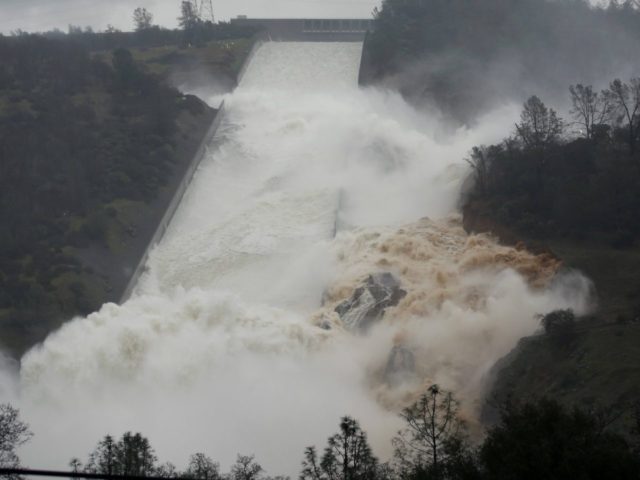The Oroville Dam crisis is highlighting concerns that there are substantial risks to the integrity of California’s 1,500 regulated dams due to age and infrastructure underfunding.
The spillway near-failure at Oroville Dam is being blamed on the “snow water equivalents” in the Northern Sierra Mountains being at 143 percent of normal average for this time of year. But the “snow water equivalents” in the Central Sierra Mountains are even higher, at 182 percent of average, and the measure for the Southern Sierra Mountains is at 192 percent.
That explains why the earthen New Don Pedro Reservoir is also at 97 percent of capacity. Holding back about two-thirds of the water as giant Oroville Lake, egineers are about to open the New Don Pedro Dam emergency spillway for only the second time in its 46-year history
The California Department of Water Resources directory of “Jurisdictional Dams” lists 50 pages. with 30 dams per page, that are on the “National Dam Registry.” About 1,250 are under the sole regulatory authority of the state, and another 250 dams are jointly regulated by the supposedly independent Federal Energy Regulatory Commission (FERC).
FERC, as an independent agency, gives the majority party in the U.S. Senate the right to appoint 3 seats, and the minority 2 seats, to four-year terms. But both FERC Republican appointees have resigned, and the 3 remaining Democrat appointees will soon be down to 2 Democrats on February 3, when Democrat appointee Norman Bay will resign. Given that it takes a minimum of 60 days to fill a seat, FERC will lack a quorum until May to make decisions for all but most serious emergency situations.
Oroville Dam, as a state-owned facility, is an example of the risk from both Democrat and Republican governors slashing infrastructure spending by 83 percent from a national high 20 percent of the state budget 40 years ago, to the nation’s second worst at 3.4 percent this year, according to a study by the Center for Budget and Policy Priorities.
The American Society of Civil Engineers (ASCE) warned in 2013 that California has a $65 billion infrastructure investment deficit in providing an adequate level of public infrastructure for dams, waterways, airports, roads, bridges, seaports and tunnels.
ASCE warned in 2013 that “Investment in infrastructure is vital to our state’s productivity, competitiveness and economic well-being.” And in a warning that should have been heeded, ASCE highlighted in its “Infrastructure Report Card” that levees/flood control was California’s most neglected sector, earning a “D” grade.
ASCE also warned that to prevent major flooding from storms, California would need to invest “$2.8 billion per year for the next 10 years” to bring its channels, levees, dams and pumping stations up to proper condition to protect thousands of homes, businesses and critical community infrastructure.
But Breitbart News has reported that the ability of California to reverse course and start funding infrastructure is highly constrained. Gov. Jerry Brown warned in January that despite economic growth of 3.29 percent, California’s $122.8 billion budget will suffer its first deficit since 2012, as state spending has grown by 7.46 percent per year.
In the past, California could borrow tens of billions of dollars, but the state and local governments now owe $1.3 trillion for bonds, loans, debt guarantees, unfunded public employee pensions and post-employment benefits. With debt of 52 percent of GDP, “California taxpayers are shouldering debt burdens on a par with residents of peripheral Eurozone states,” according to a new report from the California Policy Center.

COMMENTS
Please let us know if you're having issues with commenting.